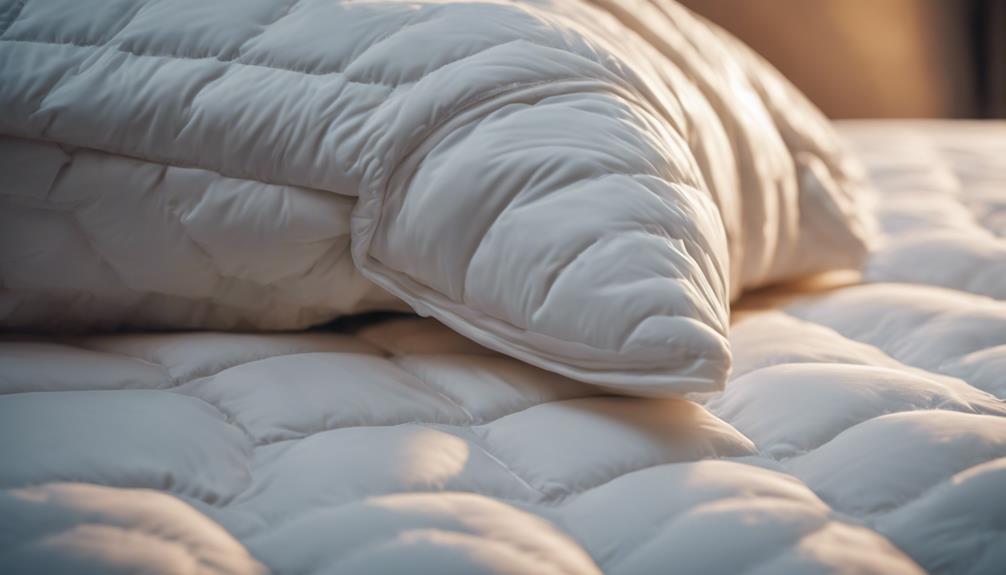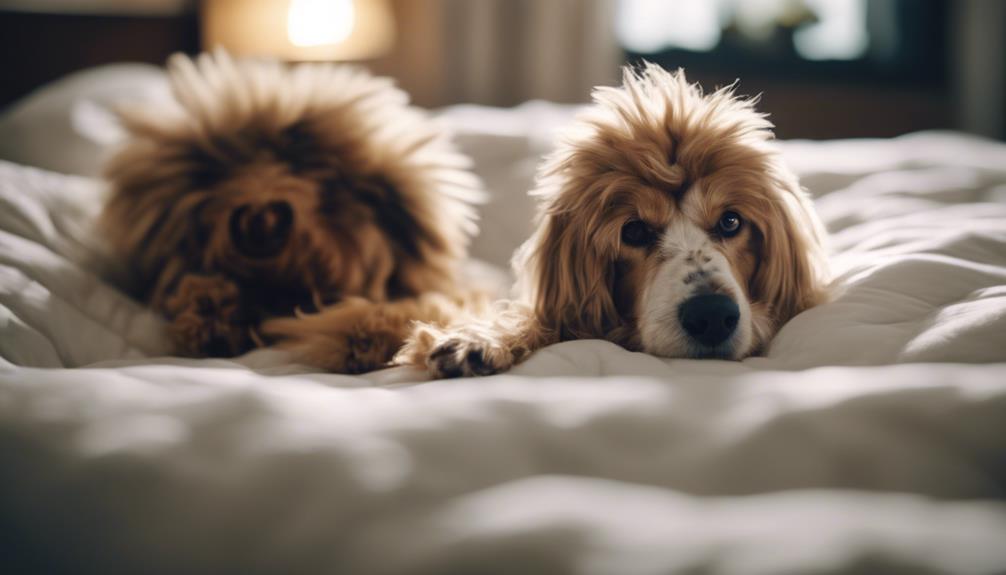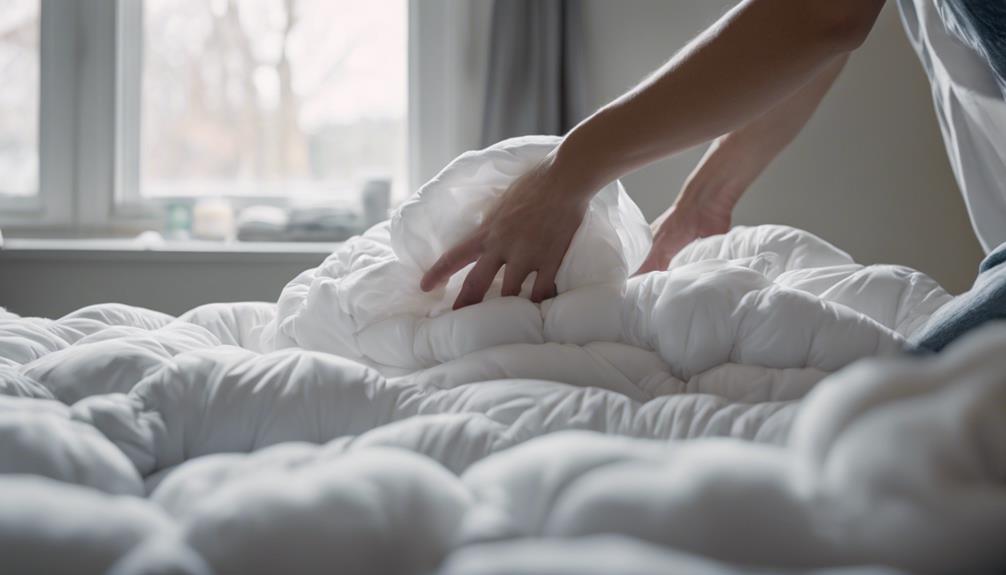Comforters are designed to efficiently trap body heat using insulating materials such as down, wool, or synthetic fibers. These materials capture warmth and help maintain a regulated temperature for a comfortable night’s sleep. The outer shell fabric ensures even heat distribution and protects the filling. The type of filling used in a comforter affects its heat retention and insulation levels. Customizable thickness options are available to cater to individual warmth preferences. By considering personal needs for warmth, material, and design, choosing the right comforter can be enhanced. For more information on the functionality and benefits of comforters, those interested in learning more about their bedding essentials can explore further details.
Key Takeaways
- Comforters trap body heat with insulating materials.
- Insulation layer distributes and retains warmth evenly.
- Outer shell protects filling and aids in temperature regulation.
- Design elements like stitching and patterns enhance durability.
- Different fill materials impact comforter's heat retention and insulation.
Insulating Materials in Comforters
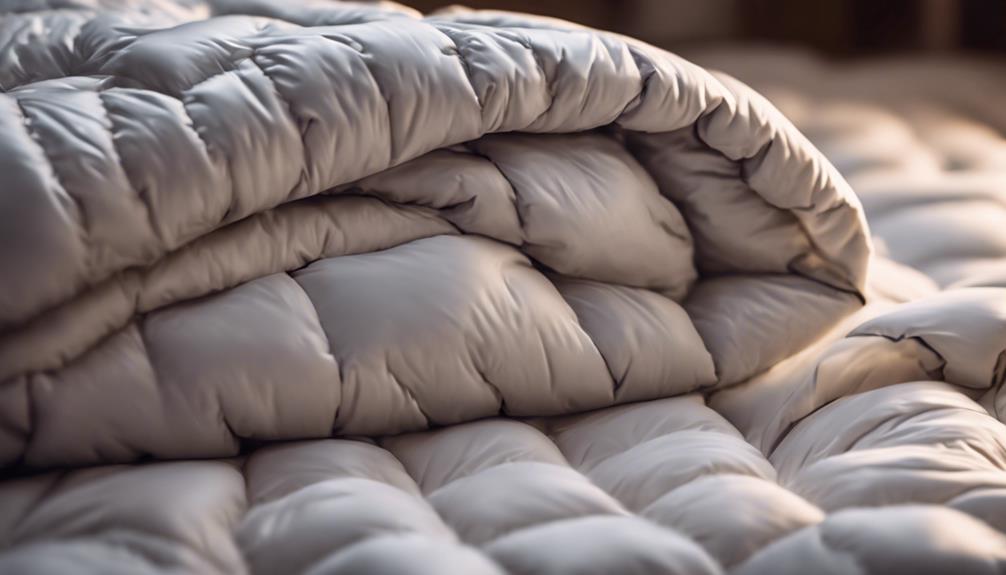
When selecting insulating materials for comforters, we prioritize their ability to trap heat efficiently while considering factors like weight and breathability.
Down comforters are renowned for their exceptional warmth-to-weight ratio, making them a preferred choice in colder climates. The lofty clusters of down create pockets of air that insulate effectively, providing a cozy sleep experience without feeling heavy on the body.
Wool comforters, on the other hand, offer natural breathability and moisture-wicking properties, helping regulate body temperature for a comfortable rest throughout the night. Their ability to adjust to the body's temperature fluctuations makes them versatile for various seasons.
Synthetic fiber-filled comforters are a practical option for those with allergies, as they're hypoallergenic and often more budget-friendly than natural materials. The choice of insulating material in a comforter significantly impacts its weight, breathability, and overall warmth, catering to individual preferences and needs for a restful night's sleep.
Function of Comforter Outer Shell
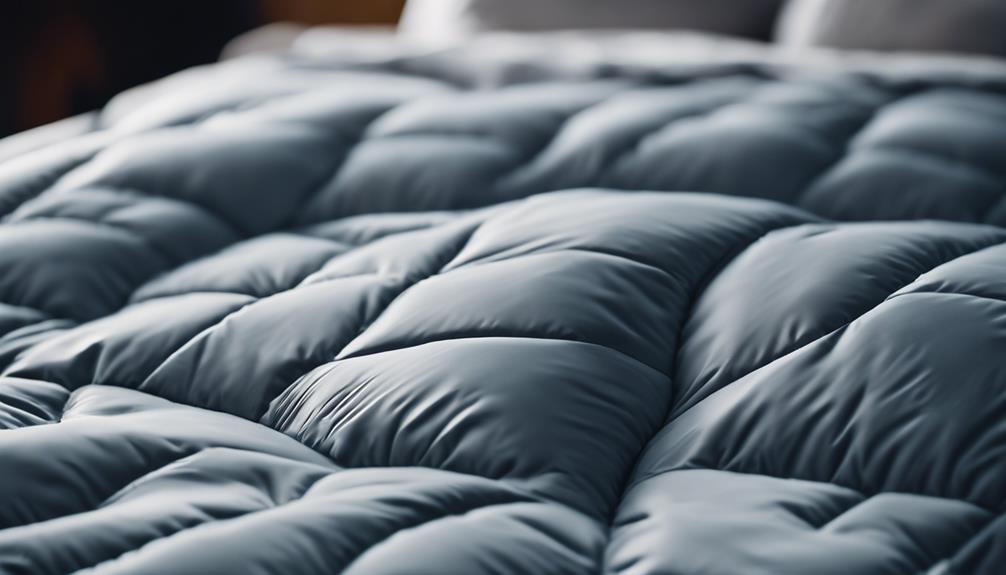
The outer shell of a comforter serves as a vital barrier for the inner filling, ensuring it remains in place for consistent warmth distribution.
It also plays an essential role in determining the comforter's durability and feel, with various materials like cotton, silk, wool, and eucalyptus offering different attributes.
Additionally, the design of the shell contributes to the overall aesthetic of the comforter and can impact the breathability and temperature regulation for a comfortable sleeping experience.
Insulation Layer Purpose
Nestled within the outer shell of a comforter lies the essential insulation layer, diligently capturing and retaining heat to guarantee a cozy night's rest.
This insulation layer is indispensable for warmth distribution, ensuring that you stay comfortably warm throughout the night. By trapping heat efficiently, the outer shell helps regulate the temperature, creating a snug environment for sleep.
Additionally, the outer shell plays an important role in the longevity of the comforter by protecting the filling material. With materials like cotton or silk known for their breathability, the outer shell not only insulates but also provides a comfortable sleeping experience.
Hence, the insulation layer within the outer shell is critical for maintaining a cozy and restful night's sleep.
Fabric Durability Importance
Ensuring the durability of a comforter, the quality of its outer shell fabric is essential for withstanding regular use and maintaining longevity.
The fabric of a comforter's outer shell plays an important role in its overall durability. Materials like cotton, silk, and eucalyptus are known for their excellent durability, ensuring the comforter can withstand frequent use and washing.
Proper care and maintenance of the outer shell fabric are key factors in extending the comforter's lifespan. Fabric durability is important for preventing tears, snags, and general wear over time, making it an essential consideration when selecting a comforter.
Choosing a high-quality fabric for the outer shell can have a significant impact on the comforter's longevity and overall performance.
Design Aesthetic Considerations
To enhance the durability and functionality of a comforter, considering design aesthetic considerations for the outer shell plays a significant role in both the visual appeal and performance of the bedding. The outer shell's design aesthetics, such as patterns and stitching, not only contribute to the overall look of the comforter but also serve a functional purpose. By incorporating visually appealing patterns and reinforced stitching, the outer shell prevents the fill from clumping, ensuring an even distribution throughout the comforter. Additionally, the fabric texture of the outer shell influences the feel and appearance of the comforter. This combination of design elements not only adds warmth and style to the bedding but also enhances its durability, making it a practical and visually pleasing choice.
| Design Aesthetic Considerations | Function |
|---|---|
| Patterns | Prevents fill clumping |
| Stitching | Reinforces durability |
| Fabric Texture | Influences feel and appearance |
Standalone Bedding Piece
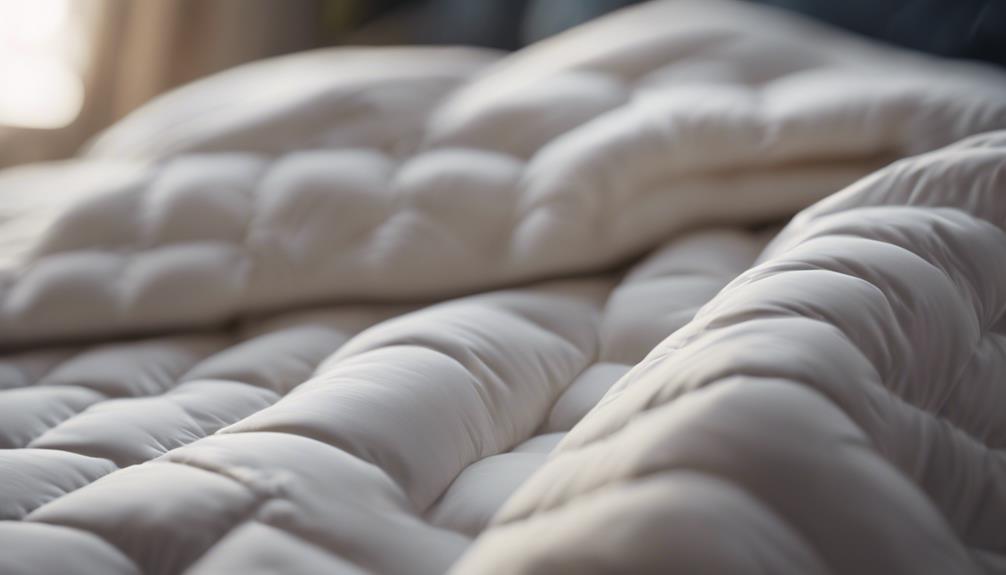
Comforters provide a guarantee of warmth and comfort on their own as a single bedding piece, consisting of two fabric layers stitched together with a soft filling in between. They offer a cozy layer on the bed and are fluffier and heavier than duvets and blankets, making them perfect for colder nights.
The construction of comforters typically includes at least three layers to guarantee warmth and comfort. Various sizes and fillings such as cotton, wool, polyester, down, or silk cater to different preferences and needs. These fillings contribute to the insulation properties of the comforter, trapping heat and maintaining a comfortable temperature throughout the night.
Whether you prefer a lightweight option for warmer seasons or a thicker one for winter, comforters serve as versatile standalone bedding pieces that can be customized to meet your specific requirements for a good night's sleep.
Customization of Comforter Thickness
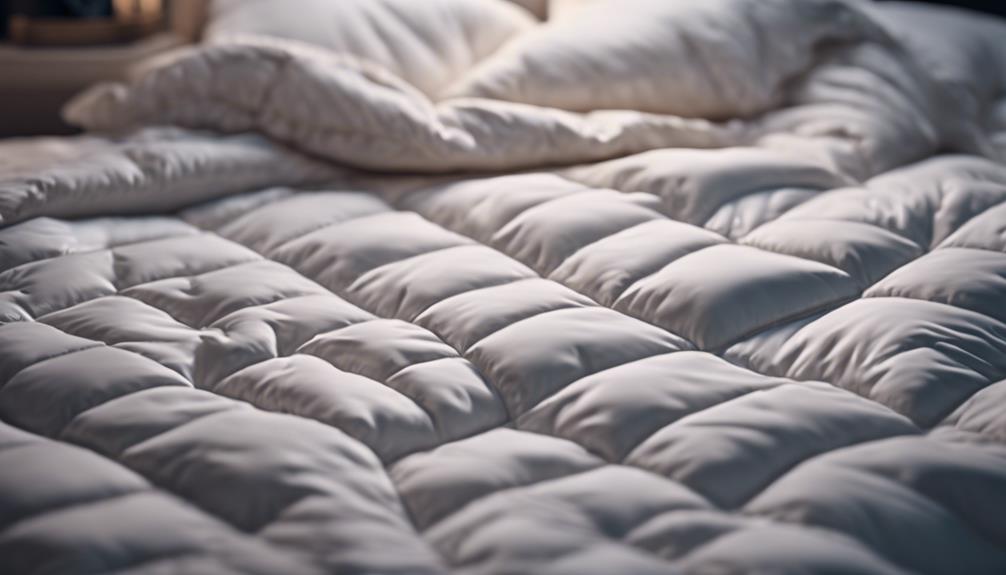
Selecting the appropriate fill power for a comforter allows for customizable thickness options tailored to individual preferences and climate requirements. Fill power is vital in determining the thickness and insulation of a comforter. Higher fill power ratings result in thicker and warmer comforters, while lower fill power ratings lead to thinner and lighter options.
The range of fill power typically starts at 300 for lightweight comforters and can exceed 800 for ultra-warm choices. The thickness of a comforter plays a significant role in its warmth and weight, as thicker comforters offer more insulation but may feel heavier.
Role of Comforter in Providing Warmth
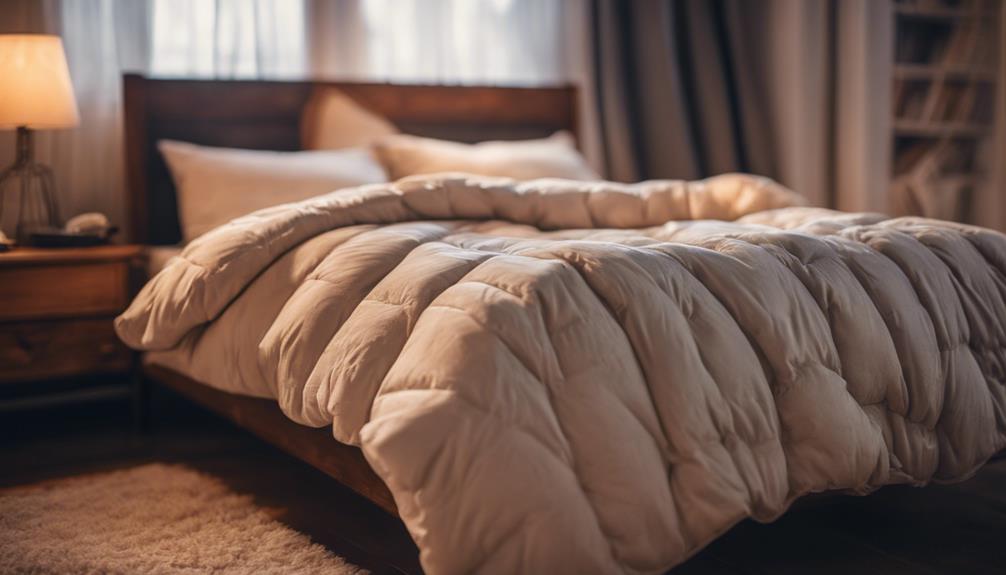
Comforters play an essential role in keeping us warm at night by trapping body heat within their layers.
The insulating material type and strategic layering of a comforter are key factors in retaining heat and providing comfort.
Understanding how these elements work together can help optimize the warmth and coziness a comforter offers during sleep.
Insulating Material Type
Using a variety of materials such as down, feathers, wool, or synthetic fibers, comforters effectively trap heat to provide warmth for a restful night's sleep. The insulating material within a comforter, like down, feathers, or synthetic fibers, plays an essential role in retaining body heat.
Down, known for its exceptional insulating properties, creates pockets that trap warm air, keeping you cozy throughout the night. Feathers and synthetic fibers also provide insulation, though to varying degrees. Additionally, comforters with quilted stitching help distribute the filling evenly, preventing clumping and ensuring consistent warmth.
The outer fabric of the comforter acts as a protective layer, further enhancing insulation by reducing heat loss. Selecting a comforter with the right insulating material is key to a comfortable and warm sleep environment.
Layering for Heat
Layered within a comforter, the combination of outer shell and inner fill forms a barrier that effectively traps body heat, ensuring warmth throughout the night.
When it comes to layering for heat in comforters, there are a few key points to keep in mind:
- Insulation Properties: The layers of a comforter play an essential role in providing insulation to regulate body temperature and keep sleepers warm.
- Material Impact: Different fill materials like down, synthetic fibers, or wool impact the comforter's ability to retain heat and provide warmth.
- Heat Retention: The design of a comforter is specifically engineered to prevent heat loss, helping to maintain a comfortable sleeping temperature and ensuring a cozy night's rest.
Elimination of Additional Bedding Layers
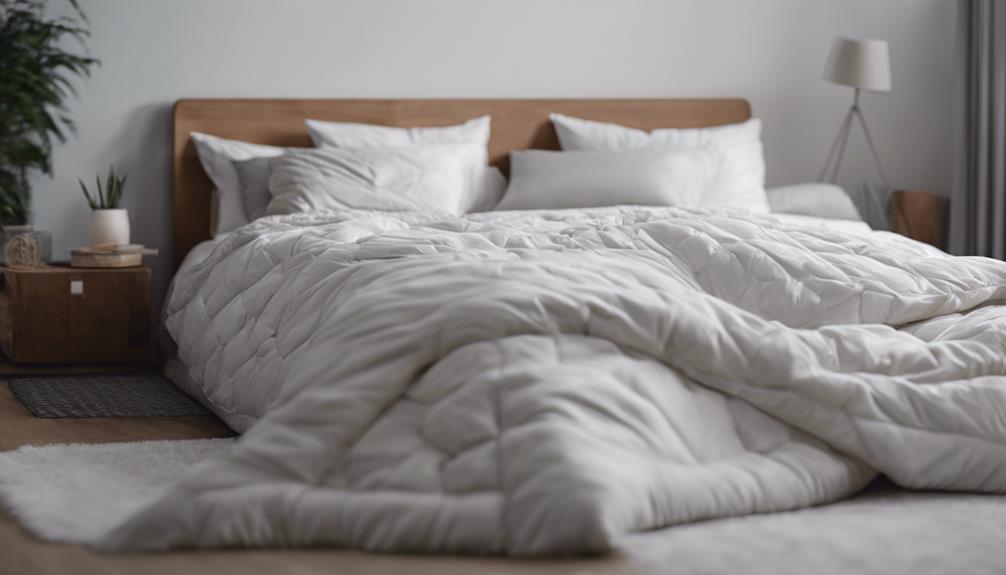
Simplifying the bedtime routine, comforters replace the need for additional bedding layers through their innovative design. By incorporating multiple layers of fabric and insulation, comforters effectively provide warmth and create a cozy environment for a restful night's sleep.
The unique construction of comforters allows them to trap heat efficiently, eliminating the necessity for extra covers like blankets or quilts. Unlike traditional bedding options, comforters are typically thicker and fluffier, offering sufficient insulation on their own. This feature not only streamlines the bed-making process but also adds a stylish and functional focal point to the bedroom.
As standalone bedding pieces, comforters stand out for their ability to provide both comfort and practicality, making them a versatile choice for creating a snug and inviting sleeping space. With their ability to offer warmth and coziness without the need for additional layers, comforters are a convenient and effective bedding solution.
Variation in Comforter Insulation Levels
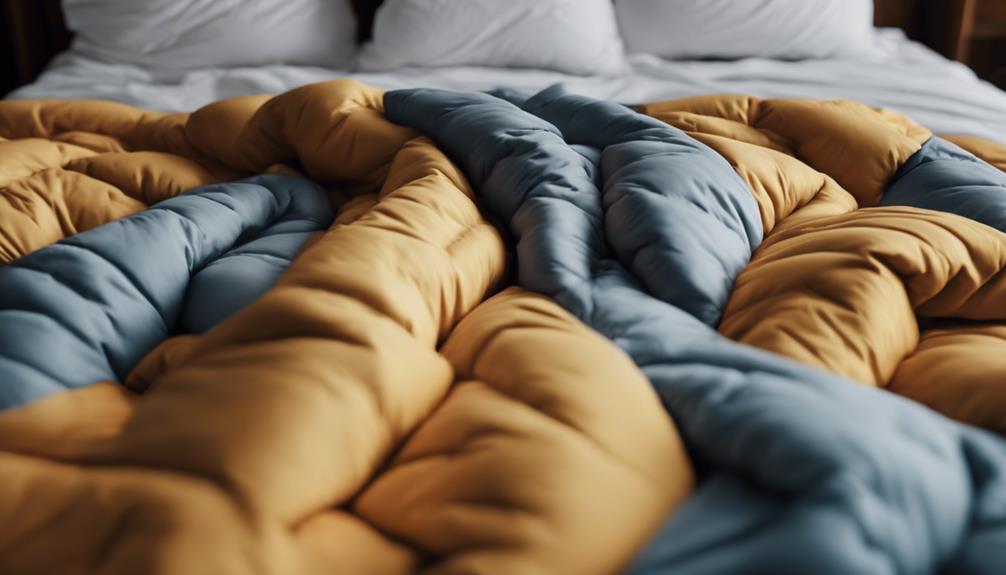
When considering comforters, it's important to understand the variation in insulation levels. Different comforters offer a range of warmth options, from lightweight to extra-warm.
Factors such as the type and amount of filling used determine the insulation level, impacting the comforter's suitability for different seasons.
Insulation Material Types
When contemplating comforter insulation materials, understanding the benefits each material offers is crucial. Here are three common types:
- Down and Feathers: Renowned for their exceptional warmth and insulation properties due to the natural loft and air-trapping abilities of down clusters.
- Synthetic Fill: Perfect for individuals with allergies to down or feathers, as synthetic fill comforters are hypoallergenic and provide reliable insulation.
- Wool: Provides natural insulation, moisture-wicking capabilities, and temperature regulation, ensuring a comfortable night's sleep.
Considering these options can assist you in choosing a comforter that aligns with your preferences and needs.
Warmth Level Options
Exploring the warmth level options in comforters reveals a range of insulation levels tailored to different climate conditions and personal preferences. Comforters offer varying degrees of warmth through different insulation levels, determined by the fill material and fill power. Materials like down, feathers, wool, cotton, or synthetic fibers provide different levels of insulation.
The thickness and density of the fill play a significant role in a comforter's ability to retain heat. Higher fill power, often found in down or feather-filled comforters, offers superior warmth due to increased loft and air-trapping capabilities. When choosing a comforter, consider your local climate and personal comfort preferences to secure a restful night's sleep.
Understanding these warmth level options helps in selecting the most suitable comforter for your needs.
Seasonal Suitability Differences
As we consider the seasonal suitability differences in comforters, it becomes evident that the variation in insulation levels plays an important role in providing ideal warmth throughout the year.
The insulation level of a comforter, determined by its fill material and thickness, dictates how effectively it traps body heat, ensuring a cozy sleep experience.
Lighter comforters are perfect for warmer seasons due to their lower insulation levels, while heavier ones with increased insulation are more suitable for colder seasons to provide enhanced warmth.
Understanding the seasonal suitability of comforters is essential in selecting the right one to maintain comfort and regulate body temperature year-round.
Comforter Personalization Based on Preferences

By understanding individual preferences such as warmth level, material, and design, comforters can be personalized to cater to specific needs and tastes.
When it comes to comforter personalization, there are various options available to make sure that your bedding meets your requirements. Preferences for comforter thickness, fill type (whether down, synthetic, or wool), and size can all be tailored to suit different needs.
Some comforters even offer adjustable warmth levels through features like removable layers or different fill densities, allowing you to customize the coziness level based on your preferences.
Personalization options extend to selecting hypoallergenic materials, eco-friendly choices, and specific thread counts for added comfort and peace of mind.
Additionally, customization features such as reversible designs, pattern choices, and a variety of color options enable you to add a unique and personalized touch to your bedding, ensuring that your comforter reflects your individual style and preferences.
Benefits of Comforter Size Customization

Customizing the size of a comforter guarantees a perfect fit for various bed sizes, such as twin, queen, or king. When it comes to bedding, having the right comforter size can make a significant difference. Here are some benefits of custom-sized comforters:
- Enhanced Aesthetic Appeal: Tailored comforter sizes prevent excess fabric or shortages, ensuring a neat and polished appearance for your bed.
- Personalized Comfort: By choosing the right comforter size, you can enjoy ideal coverage and comfort tailored to your individual preferences, promoting a restful night's sleep.
- Seamless Coordination: Custom-sized comforters allow for a seamless look when paired with matching duvet covers or bed linens, creating a cohesive and well-coordinated bedding ensemble.
Choosing the appropriate comforter size not only adds to the overall aesthetics of your bedroom but also guarantees practical benefits such as preventing shifting or bunching, maintaining a tidy and cozy bed look.
Seasonal Adaptability With Comforters
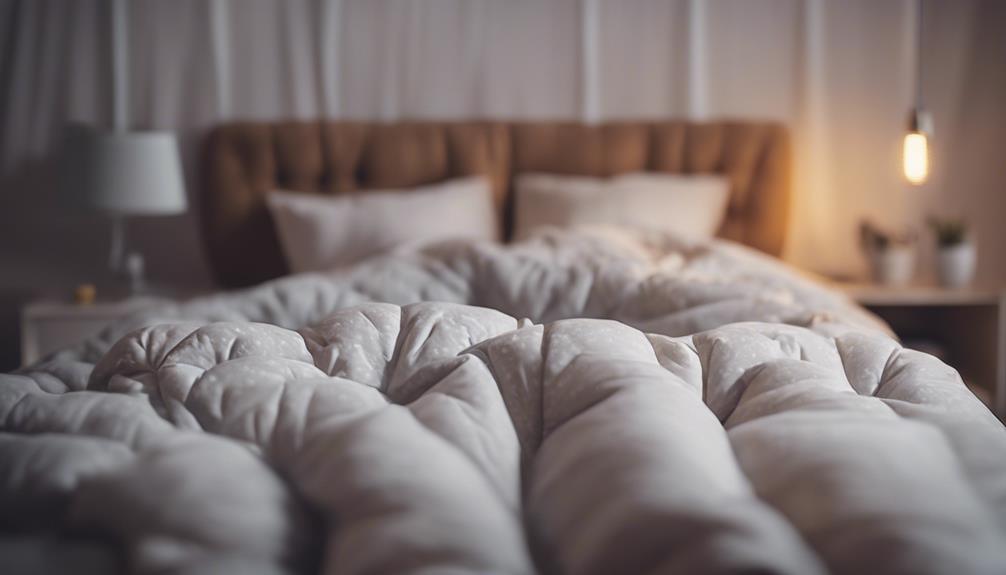
Comforters adapt to seasonal changes by providing warmth in colder months and breathability in warmer seasons, ensuring comfort year-round. The seasonal adaptability of comforters is achieved through the selection of suitable fillings like down, synthetic fibers, or wool, depending on local weather conditions.
Lightweight comforters are perfect for summer, allowing airflow and preventing overheating, while heavier comforters offer insulation and coziness during winter months. This versatility allows comforters to be layered with sheets for extra warmth or used alone as the weather shifts.
Frequently Asked Questions
Do You Sleep on Top or Under a Comforter?
We typically sleep under a comforter. Placing it on top of the sheets provides an additional layer of warmth and insulation, keeping us cozy during sleep.
This setup helps regulate body temperature and guarantees a comfortable sleeping experience. The soft filling inside the comforter adds to its insulating properties, creating a snug and inviting bed environment.
Do You Need a Blanket With a Comforter?
We don't necessarily need a blanket with a comforter. Comforters are designed to provide warmth and insulation on their own, without the need for an extra layer. Some people prefer using a comforter alone to simplify bedding and reduce bulk on the bed.
However, the choice to use a blanket with a comforter ultimately depends on personal preference for added warmth and comfort. It's a matter of individual needs and comfort levels.
Do You Put Something Over a Comforter?
Yes, it's common to put something over a comforter for added warmth or style. Duvet covers and top sheets are popular choices. Duvet covers protect the comforter and are easy to wash, making them durable.
Top sheets offer a way to change up the bedding look easily. Adding layers like quilts or throws can provide extra coziness and visual interest.
Coverlets or bedspreads can add texture and flair to your bedding ensemble.
How Do Cooling Comforters Work?
Cooling comforters work by using breathable fabrics and cooling gel or fibers to regulate body temperature during sleep. They promote air circulation and prevent heat buildup, making them ideal for hot sleepers.
These comforters are lightweight and designed to provide a cooler sleep experience in warmer climates. One interesting statistic is that cooling comforters can lower body temperature by a few degrees, enhancing comfort and improving sleep quality.
Do Hilton’s Comforters Work the Same Way as Regular Comforters?
Yes, Hilton comforter details reveal that they work similarly to regular comforters. They are designed to provide the same level of warmth, comfort, and style. The key difference lies in the quality of materials and construction, ensuring a luxurious experience for guests at Hilton properties.
Conclusion
To sum up, comforters work by using insulating materials to trap heat and provide warmth while sleeping.
Did you know that the average person spends about one-third of their life in bed? That's a lot of time to enjoy the comfort and coziness that a good comforter can provide.
So, choose a comforter that suits your preferences and needs, and enjoy a restful night's sleep all year round.
